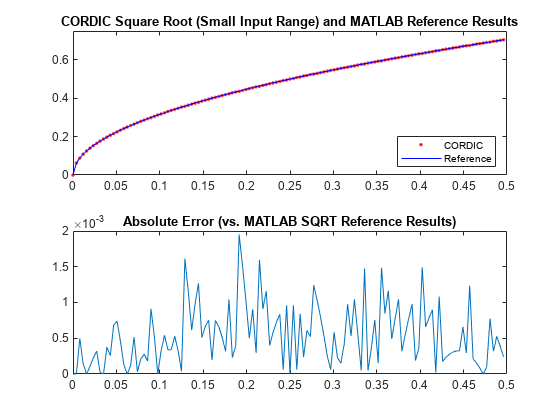使用 CORDIC 计算平方根
此示例说明如何在 MATLAB® 中使用 CORDIC 核算法计算平方根。基于 CORDIC 的算法对许多嵌入式应用至关重要,包括电机控制、导航、信号处理和无线通信。
CORDIC 是 COordinate Rotation DIgital Computer(坐标旋转数字计算方法)的缩写。基于吉文斯旋转的 CORDIC 算法是最节省硬件资源的算法之一,因为它只需进行迭代移位相加运算 [1,2]。CORDIC 算法不需要显式乘数,它适用于计算各种函数,如正弦、余弦、反正弦、反余弦、反正切、向量模、除法、平方根、双曲线和对数函数。
定点 CORDIC 算法需要以下操作:
每次迭代进行 1 次表查找
每次迭代进行 2 次移位
每次迭代进行 3 次加法
请注意,对于基于双曲 CORDIC 的算法,如平方根,某些迭代 () 会重复以实现结果收敛 [2]。
使用双曲计算模式的 CORDIC 核算法
您可以使用 CORDIC 计算模式算法来计算双曲函数,如双曲三角函数、平方根、对数、幂等。
双曲向量化模式下的 CORDIC 方程
双曲向量化模式用于计算平方根。
对于向量化模式,CORDIC 方程如下:
其中
是每 次迭代会重复步骤的序列,并且
如果 ,则 ,否则为 。
当 趋近于 时,此模式提供以下结果:
其中
.
请注意,乘积中的序列会在每 个步骤中重复 [2]。
通常,会选择一个足够大的常数值作为 的取值。因此,可以预先计算 。
另请注意,对于平方根,仅使用 结果。
在 MATLAB 中实现 CORDIC 双曲向量化算法
以下是 CORDIC 双曲向量化核算法的 MATLAB 代码实现示例(对于标量 x、y 和 z 的情况)。以下代码可同时用于定点和浮点数据类型。
CORDIC 双曲向量化核
k = 4; % Used for the repeated (3*k + 1) iteration steps for idx = 1:N xtmp = bitsra(x, idx); % multiply by 2^(-idx) ytmp = bitsra(y, idx); % multiply by 2^(-idx) if y < 0 x(:) = x + ytmp; y(:) = y + xtmp; z(:) = z - atanhLookupTable(idx); else x(:) = x - ytmp; y(:) = y - xtmp; z(:) = z + atanhLookupTable(idx); end if idx==k xtmp = bitsra(x, idx); % multiply by 2^(-idx) ytmp = bitsra(y, idx); % multiply by 2^(-idx) if y < 0 x(:) = x + ytmp; y(:) = y + xtmp; z(:) = z - atanhLookupTable(idx); else x(:) = x - ytmp; y(:) = y - xtmp; z(:) = z + atanhLookupTable(idx); end k = 3*k + 1; end end % idx loop
双曲反正切查找表 atanhLookupTable 定义如下,在代码生成中将预先计算它并成为常量。
atanhLookupTable = cast(atanh(2.^-(1:N)),'like',z);
使用 CORDIC 双曲向量化核计算平方根
明智选择的初始值允许 CORDIC 核双曲向量化模式算法计算平方根。
首先,执行以下初始化步骤:
将 设置为 。
将 设置为 。
在 次迭代后,随着 逼近 ,这些初始值会导致以下输出:
这可以进一步简化如下:
其中 是如上定义的 CORDIC 增益。
请注意,对于平方根, 和 atanhLookupTable 对结果不起作用。因此,未使用 和 atanhLookupTable。
CORDIC 平方根核的 MATLAB 实现
以下是 CORDIC 平方根核算法的 MATLAB 代码实现示例(对于标量 x 和 y 的情况)。以下代码可同时用于定点和浮点数据类型。
CORDIC 平方根核
k = 4; % Used for the repeated (3*k + 1) iteration steps for idx = 1:N xtmp = bitsra(x, idx); % multiply by 2^(-idx) ytmp = bitsra(y, idx); % multiply by 2^(-idx) if y < 0 x(:) = x + ytmp; y(:) = y + xtmp; else x(:) = x - ytmp; y(:) = y - xtmp; end if idx==k xtmp = bitsra(x, idx); % multiply by 2^(-idx) ytmp = bitsra(y, idx); % multiply by 2^(-idx) if y < 0 x(:) = x + ytmp; y(:) = y + xtmp; else x(:) = x - ytmp; y(:) = y - xtmp; end k = 3*k + 1; end end % idx loop
以下代码与上述 CORDIC 双曲向量化核实现相同,只是未使用 z 和 atanhLookupTable。这样,每次迭代都省去 1 次表查找和 1 次加法运算。
示例
使用 cordicsqrt 函数,通过十次 CORDIC 核迭代计算 v_fix 的近似平方根。
step = 2^-7; v_fix = fi(0.5:step:(2-step), 1, 20); % fixed-point inputs in range [.5, 2) niter = 10; % number of CORDIC iterations x_sqr = cordicsqrt(v_fix, niter);
获取 CORDIC 输出的真实值 (RWV) 以进行比较,并绘制 MATLAB 参考值与 CORDIC 平方根值之间的误差。
x_cdc = double(x_sqr); % CORDIC results (scaled by An_hp) v_ref = double(v_fix); % Reference floating-point input values x_ref = sqrt(v_ref); % MATLAB reference floating-point results figure; subplot(211); plot(v_ref, x_cdc, 'r.', v_ref, x_ref, 'b-'); legend('CORDIC', 'Reference', 'Location', 'SouthEast'); title('CORDIC Square Root (In-Range) and MATLAB Reference Results'); subplot(212); absErr = abs(x_ref - x_cdc); plot(v_ref, absErr); title('Absolute Error (vs. MATLAB SQRT Reference Results)');

克服算法输入范围限制
许多平方根算法将输入值 归一化到 [0.5, 2) 范围内。这种预处理通常使用固定字长归一化完成,可用于支持小输入值范围和大输入值范围。
基于 CORDIC 的平方根算法实现对超出此范围的输入特别敏感。cordicsqrt 函数通过基于以下数学关系的归一化方法克服此算法范围限制:
(适用于某些 和某些偶数 )。
因此:
在 cordicsqrt 函数中,上述 和 的值是在输入 的归一化过程中找到的。 是输入 的二进制表示中前导零最高有效位 (MSB) 的数量。这些值是通过一系列按位逻辑和移位运算找到的。请注意,因为 必须为偶数,如果前导零 MSB 的数量为奇数,则会进行一次额外的位移以使 为偶数。这些移位后的结果值是值 。
成为基于 CORDIC 的平方根核的输入,会在此处计算 的逼近。然后按 对结果进行缩放,使其回到正确的输出范围。这通过简单的按 位移位来实现。移位方向(左或右)取决于 的符号。
示例
使用 CORDIC 计算具有小的非负范围的 10 位定点输入数据的平方根。在相同输入范围内,将基于 CORDIC 的算法结果与浮点 MATLAB 参考结果进行比较。
step = 2^-8; u_ref = 0:step:(0.5-step); % Input array (small range of values) u_in_arb = fi(u_ref,0,10); % 10-bit unsigned fixed-point input data values u_len = numel(u_ref); sqrt_ref = sqrt(double(u_in_arb)); % MATLAB sqrt reference results niter = 10; results = zeros(u_len, 2); results(:,2) = sqrt_ref(:);
计算等效真实值 (RWV) 结果。绘制 CORDIC 和 MATLAB 参考结果的 RWV。
x_out = cordicsqrt(u_in_arb, niter); results(:,1) = double(x_out); figure; subplot(211); plot(u_ref, results(:,1), 'r.', u_ref, results(:,2), 'b-'); legend('CORDIC', 'Reference', 'Location', 'SouthEast'); title('CORDIC Square Root (Small Input Range) and MATLAB Reference Results'); axis([0 0.5 0 0.75]); subplot(212); absErr = abs(results(:,2) - results(:,1)); plot(u_ref, absErr); title('Absolute Error (vs. MATLAB SQRT Reference Results)');

示例
使用 CORDIC 计算具有大的正范围的 16 位定点输入数据的平方根。在相同输入范围内,将基于 CORDIC 的算法结果与浮点 MATLAB 参考结果进行比较。
u_ref = 0:5:2500; % Input array (larger range of values) u_in_arb = fi(u_ref,0,16); % 16-bit unsigned fixed-point input data values u_len = numel(u_ref); sqrt_ref = sqrt(double(u_in_arb)); % MATLAB sqrt reference results niter = 16; results = zeros(u_len, 2); results(:,2) = sqrt_ref(:);
计算等效真实值 (RWV) 结果。绘制 CORDIC 和 MATLAB 参考结果的 RWV。
x_out = cordicsqrt(u_in_arb, niter); results(:,1) = double(x_out); figure; subplot(211); plot(u_ref, results(:,1), 'r.', u_ref, results(:,2), 'b-'); legend('CORDIC', 'Reference', 'Location', 'SouthEast'); title('CORDIC Square Root (Large Input Range) and MATLAB Reference Results'); axis([0 2500 0 55]); subplot(212); absErr = abs(results(:,2) - results(:,1)); plot(u_ref, absErr); title('Absolute Error (vs. MATLAB SQRT Reference Results)');

参考资料
Jack E. Volder, "The CORDIC Trigonometric Computing Technique," IRE Transactions on Electronic Computers, Volume EC-8, September 1959, pp. 330-334.
J.S. Walther, "A Unified Algorithm for Elementary Functions," Conference Proceedings, Spring Joint Computer Conference, May 1971, pp. 379-385.